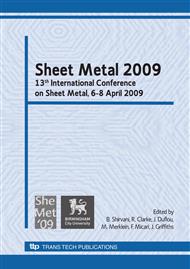p.533
p.543
p.555
p.565
p.571
p.579
p.587
p.595
p.601
Prevention of Partial Draw-In During High Speed Deep Drawing
Abstract:
Due to an ongoing trend of function compaction miniaturization gets more and more important in industrial production. Through the growing miniaturization new difficulties have overcome like scaling effects. However, on the other hand scaling towards smaller parts enables the application of new technologies which do not work in macro engineering. One such method is high speed deep drawing which is based on TEA-CO2-laser induced shock waves. This process utilizes an initiated plasma shock wave on the target surface, which leads to forming of the sheet. Several pulses can be applied at one point and therefore a high forming degree can be reached without increasing the energy density. In this article this non-mechanical forming process is applied and a concept for the prevention of partial draw-in is discussed. Therefore potentially influencing factors are investigated.
Info:
Periodical:
Pages:
571-578
Citation:
Online since:
March 2009
Authors:
Price:
Сopyright:
© 2009 Trans Tech Publications Ltd. All Rights Reserved
Share:
Citation:


